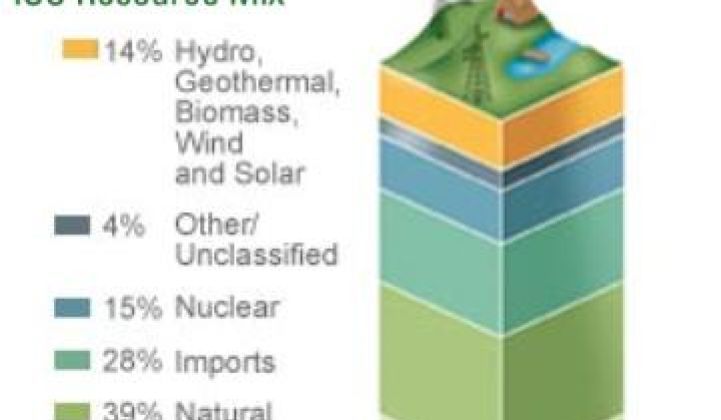Californians gathered in Los Angeles for the fourth annual VerdeXchange, a business-to-business cross-platform cleantech conference, seemed a little dazed this year, caught between the exhilaration of having a standard requiring utilities to obtain a third of their power from renewable energy by 2020 and panic at having to implement such a standard.
Their problem is simple but not easy. If environmental impact complications don’t prevent the state’s developers from generating that much renewable energy, the California Independent System Operator (CaISO) and a bunch of smaller transmission system players will have to bring that much renewable energy onto the grid despite regulatory complications from FERC and the CPUC and the fact that renewable’s variability make them seem an almost unmanageably different sort of thing from coal, natural gas and nuclear power to grid operators and utilities.
“The whole job of the grid operator is to manage the load and the resources,” said V. John White, Executive Director of the Center for Energy Efficiency and Renewables Technologies (CEERT). “If you knew how complicated it was, you’d be amazed.”
Introducing Southern California Edison (SCE) Engineer Mike Montoya, White said the utility-scale integration of renewables into the transmission system “is like building a symphony orchestra. We’re going to have lots of different instruments,” he said. “The [challenge] is to harmonize them.”
Montoya laid out the cacophony of renewables integration, from SCE’s point of view, in a nine-point litany. “Voltage control is going to be a real issue for us,” he began. As demands and supplies of energy vary, there are voltage control problems and the “potential of reverse flow.” There is the handling emergency interruptions, the management of power quality, the balancing of load and generation, the regulating of load, and the managing of reserve capacity and ramping capability.
He neglected to mention that these are familiar challenges because they come to some degree with the management of traditional power sources and are issues with which CaISO and other operators are already contending successfully as they integrate renewables into the system.
A newer issue is what the utilities have dubbed Wide Area Situational Awareness and Wide Area Control. It is a solution to the drawing of power from a much larger geographic region. California is expected to eventually obtain its renewable resources from the Pacific Northwest to Baja California and as far into the Western states as Utah and New Mexico.
This represents a challenge as well as an opportunity, introducing a much larger array of sources as well as a much larger transmission base. SCE is already preparing to take advantage of the opportunity in the challenge with what Montoya called “a synchrophasor technology which is looking at a power system at 30 samples per second such that we can have a really detailed view of what’s going on” because “a human interface for a system of this type will not work.”
SCE is also studying storage, Montoya said. Stored energy makes sense to seasoned operators and utilities because it can be dispatched as needed, as if it were traditional generation, and therefore relieves them of dealing with the complexities of variability and situational awareness and learning to use information technology that samples a power system 30 times per second.
SCE is building an eight-megawatt lithium-ion battery facility in the renewables-rich Tehachapi region where the utility last year completed a substation now capable of delivering 1,500 megawatts of wind power to the Los Angeles region.
By the time Tehachapi has built out a planned 4,500 megawatts of wind power, SCE intends to know much more about the costs and benefits of large- and small-scale battery storage. In addition to the eight-megawatt facility, Montoya said, SCE is developing one megawatt to four megawatt transportable storage units, 25 to 50 kilowatt community energy storage units, and residential battery systems incorporating rooftop solar, smart appliances and electric vehicles.
According to Osamu Onodera of Japan’s New Energy and Industrial Technology Development Corp (NEDO), utilities and system operators are also working through trials of storage and integration in Japan. To achieve integration of renewables commensurate with mandated standards there, investment in Japan may reach $600 billion. But “we don’t really know what the right answer is right now. We don’t know where to put the batteries or what kind of renewables will go on the grid.”
They are experimenting, he said, with wind and solar as well as larger and more concentrated areas. They are also carefully studying the impact on the grid of the large-scale introduction of EVs. And they are looking at how integration works elsewhere. Renewables integration, Onodera said, ‘is very different in different countries. The solution is probably not one.”
Shawn Kelly of San Francisco-based consultancy AECOM reemphasized the inadequacy of the existing grid and noted that most of whatever spending is done on it goes to maintenance, not modernization.
White wrapped up the presentation by describing what has to happen to quiet the cacophony and meet the 33% by 2020 renewables standard. “Ultimately, these are not technically difficult models,” he said. “They are politically difficult because they require people to get outside their respective comfort zones and fixations.” But, he added, “we’ve got to find a way to have everybody raise the quality of their game in an effort to make this task successful.” And, he said. “I don’t think it’s a question of whether it can be done, it’s a question of how it can be done.”



